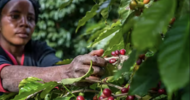GRAIN | December 2011 | Español | français
New data sets on land grabbing
In the past few months, GRAIN staff have been participating in a range of meetings and workshops in different parts of the world on land grabbing. Most of these events have been organised by small farmers' organisations, others by civil society groups. GRAIN's role has often been to provide data and analysis to feed into the debates.
As a support to these initiatives, staff have put together a number of new data sets that we would now like to share publicly for everyone's use.
One is an updated powerpoint presentation, which gives a general overview of the land grab trend. We focus here on land grabs for food production (not forestry, biofuels or tourism) and those involving international capital flows (not domestic land grabs). Our presentation stresses the role of the financial sector, because investment funds are considered by many as the key land grabbers today, along with other private sector firms.
[To download the powerpoint, click here]
[To download the PDF version, click here]
[To watch the slideshow online, click here]
Another data set is a table we compiled which shows how far this land grab process is penetrating different countries. What we calculated was the percentage of the land grabbed area -- for the production of crops and livestock -- in terms of arable land, agricultural land and total land area per country. We find the results quite instructive. But also deeply worrying.
[For PDF, click here]
A third exercise we did was to update the table we published back in June 2011 on pension funds' involved in the global land grab. As a work-in-progress this table is still incomplete, but the current version provides a more expanded picture than the original and can be helpful to some groups.
[For PDF, click here]
Solid data about land grabs is lacking, but the information we drew upon for these files comes from stories we are fairly familiar with and sources we are confident in. Hence, we are comfortable to share these materials out. Any questions, corrections or comments -- or additions! -- you may have are very welcome. Please share them in the "comments" field at the bottom of this web page or by writing to us at [email protected]. Thanks in advance.
New data sets on land grabbing
In the past few months, GRAIN staff have been participating in a range of meetings and workshops in different parts of the world on land grabbing. Most of these events have been organised by small farmers' organisations, others by civil society groups. GRAIN's role has often been to provide data and analysis to feed into the debates.
As a support to these initiatives, staff have put together a number of new data sets that we would now like to share publicly for everyone's use.
One is an updated powerpoint presentation, which gives a general overview of the land grab trend. We focus here on land grabs for food production (not forestry, biofuels or tourism) and those involving international capital flows (not domestic land grabs). Our presentation stresses the role of the financial sector, because investment funds are considered by many as the key land grabbers today, along with other private sector firms.
[To download the powerpoint, click here]
[To download the PDF version, click here]
[To watch the slideshow online, click here]
Another data set is a table we compiled which shows how far this land grab process is penetrating different countries. What we calculated was the percentage of the land grabbed area -- for the production of crops and livestock -- in terms of arable land, agricultural land and total land area per country. We find the results quite instructive. But also deeply worrying.
[For PDF, click here]
A third exercise we did was to update the table we published back in June 2011 on pension funds' involved in the global land grab. As a work-in-progress this table is still incomplete, but the current version provides a more expanded picture than the original and can be helpful to some groups.
[For PDF, click here]
Solid data about land grabs is lacking, but the information we drew upon for these files comes from stories we are fairly familiar with and sources we are confident in. Hence, we are comfortable to share these materials out. Any questions, corrections or comments -- or additions! -- you may have are very welcome. Please share them in the "comments" field at the bottom of this web page or by writing to us at [email protected]. Thanks in advance.












